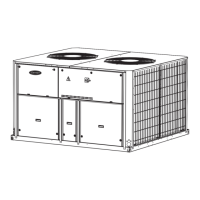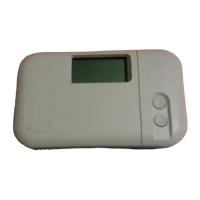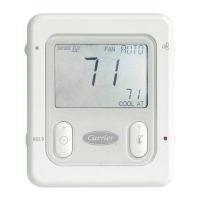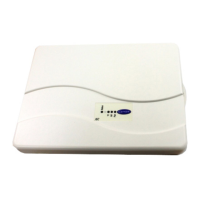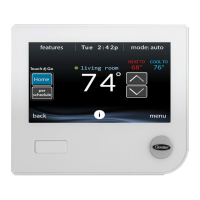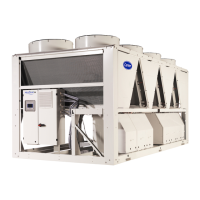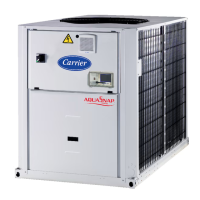25
The envelope control function is used to articially load the
chiller and keep it running under low load conditions or to
prevent surge conditions. Since this also reduces the
performance of the machine, this is a user selectable option.
There are 3 types of EC valve.
- Continuous: A valve controlled by 2 contactors, one to
open valve, the other to close valve. If both contractors
are opened, the valve will hold its position. This kind of
valve has feedback signal of fully closed or fully opened.
- On/Off: A valve controlled by only 1 contactor. It can’t hold
its current position, and has no position feedback signal.
- mA: A valve controlled by 4-20mA signal. It has the
most precise control and feedback.
- Envelope Control Valve operation will have three
different modes when installed (hgbp_opt>0) and
enabled (hgbp_sel>0).
- Envelope Control for surge correction
Most of the inputs to the function are required for determining
the operating region for the compressor map. Each compressor
has unique lift characteristics that can be plotted to determine
performance. The controller will determine operating
conditions that could result in surging of the compressor and
activate the Envelope Control valve to prevent surge until
the chillers operating parameters are in a safe area on the
curve where the valve may be closed again.
- Envelope Control for low load operation
In this condition, envelope control valve will be opened to
prevent a recycle shutdown from occurring. The envelope
control valve will remain open until this minimal loading
condition has passed and there is no surge condition present.
- Combination for surge correction and low load operation
When this option is selected, both EC for surge correction
and EC for Low Load Operation will be performed. Surge
condition will take higher priority if both conditions are
satised.
The economizer damper control is to maintain the pressure
difference between Evaporator Pressure and Economizer
Pressure. Pressure in economizer should be always kept
higher than the pressure in evaporator.
If the Chiller Type (Conguration Menu – Factory Parameters)
is congured to 19XR2~E/V/D and without this electrical
damper valve, this function shall be bypassed.
When the chiller is initially powered ON, the damper valve
will be commanded to close. When compressor shuts down,
the damper valve will be commanded to close.
The damper valve shall be acted based on the following table:
Chiller initially Power ON Fully Close
Compressor shutdown Fully Close
During Damper Valve Act Delay Fully Close
Economizer Pressure > Evaporator
Pressure + Damper Valve Open DB
Open
Economizer Pressure < Evaporator
Pressure + Damper Valve Close DB
Close
Otherwise Keep the current position
Economizer Damper Control - 1
If the damper valve has been command to open for a
continuous 5 minutes, and the Damper Valve Full Opened
is still not TRUE, then control system should generate an
alert 154.
If the damper valve has been command to close for a continuous
5 minutes, and the Damper Valve Full Closed is still not TRUE,
then control system should generate an alert 154.
If compressor is running and if economizer pressure becomes
less than or equal to evaporator pressure, alarm 268 shall be
tripped and compressor shall be shutdown.
For 19XRC improvement unit, there is vapor source damper
which is controlled by a NC(normal closed when valve coil
is deenergized) solenoid valve and the pressure difference
between damper cap and ow passage.
The SV is closed when chiller is not running, and keep closed
until a delay period after chiller starts up(delay timer vssv_dly
is congurable in CONF_OPT table). And after this timer is
timeout, the SV should be energized.
The 19 Series PIC 5+ controls provide a feature for limiting
AVERAGE LOAD CURRENT or Motor KILOWATTS by
limiting capacity via guide vane control/VFD control. The
limit applied is called ACTIVE DEMAND LIMIT, which is
equal to a BASE DEMAND LIMIT value (set in the
SETPOINT Screen, default value 100%), or be determined
by AUTO DEMAND LIMIT INPUT (an optional 4-20 mA
input, described below). ACTIVE DEMAND LIMIT may
also be forced to be different from BASE DEMAND LIMIT
by manually overriding the value (forcing) writing a value
via a CCN network device.
If the DEMAND LIMIT SOURCE exceeds the ACTIVE
DEMAND LIMIT by 5% or less, capacity will be inhibited.
If the DEMAND LIMIT SOURCE exceeds the ACTIVE
DEMAND LIMIT by more than 5%, capacity will be
decreased.
Demand Limit Control Option — the demand limit control
option (4-20 mA DEMAND LIMIT TYPE) is externally
controlled by a 4 to 20 mA signal. The option is set up on the
CONFIGURATION MENU/GENERAL
CONFIGURATION screen. When enabled, 4 mA will set
ACTIVE DEMAND LIMIT to 100% of the DEMAND
LIMIT SOURCE (regardless of the value of BASE
DEMAND LIMIT), and 20 mA will set ACTIVE DEMAND
LIMIT to the value congured as “DEMAND LIMIT AT
20 mA” in the CONFIGURATION MENU/SERVICE
PARAMETERS screen.

